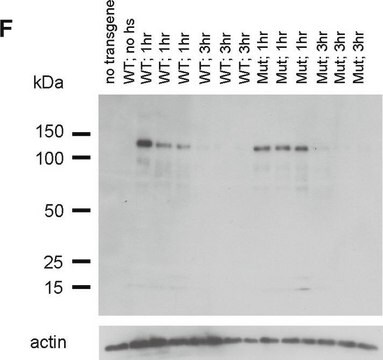A2103
Anti-Actin, N-terminal antibody produced in rabbit

~0.5 mg/mL, affinity isolated antibody, buffered aqueous solution
Sinónimos:
Actin Detection Antibody, Rabbit Anti-Actin
About This Item
Productos recomendados
biological source
rabbit
Quality Level
conjugate
unconjugated
antibody form
affinity isolated antibody
antibody product type
primary antibodies
clone
polyclonal
form
buffered aqueous solution
mol wt
antigen 42 kDa
species reactivity
frog, rat, mouse, chicken, human
packaging
antibody small pack of 25 μL
enhanced validation
independent
Learn more about Antibody Enhanced Validation
concentration
~0.5 mg/mL
technique(s)
immunocytochemistry: 1-2 μg/mL using cultured chicken fibroblasts
immunohistochemistry (formalin-fixed, paraffin-embedded sections): 2-4 μg/mL using sections of human appendix, mouse heart, and frog skeletal muscle
indirect immunofluorescence: suitable
western blot: 0.5-1 μg/mL using whole extract of the human epitheloid carcinoma HeLa cell line.
western blot: 2-4 ng/mL using whole extract of rat skeletal muscle
UniProt accession no.
shipped in
wet ice
storage temp.
−20°C
target post-translational modification
unmodified
Gene Information
human ... ACTA1(58) , ACTA2(59) , ACTB(60) , ACTC1(70) , ACTG1(71) , ACTG2(72)
mouse ... Acta1(11459) , Acta2(11475) , Actb(11461) , Actc1(11464) , Actg1(11465) , Actg2(11468)
rat ... Acta1(29437) , Acta2(81633) , Actb(81822) , Actc1(29275) , Actg1(287876) , Actg2(25365)
General description
Immunogen
Application
- immunoblotting
- quantitative chromatin immunoprecipitation (qChIP)
Biochem/physiol Actions
Physical form
Other Notes
Disclaimer
¿No encuentra el producto adecuado?
Pruebe nuestro Herramienta de selección de productos.
Optional
Storage Class
12 - Non Combustible Liquids
wgk_germany
WGK 2
ppe
Eyeshields, Gloves, multi-purpose combination respirator cartridge (US)
Certificados de análisis (COA)
Busque Certificados de análisis (COA) introduciendo el número de lote del producto. Los números de lote se encuentran en la etiqueta del producto después de las palabras «Lot» o «Batch»
¿Ya tiene este producto?
Encuentre la documentación para los productos que ha comprado recientemente en la Biblioteca de documentos.
Nuestro equipo de científicos tiene experiencia en todas las áreas de investigación: Ciencias de la vida, Ciencia de los materiales, Síntesis química, Cromatografía, Analítica y muchas otras.
Póngase en contacto con el Servicio técnico








